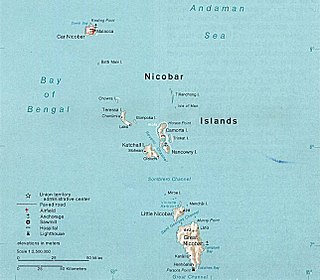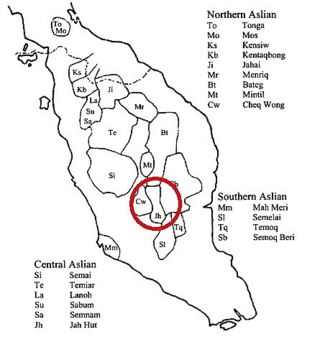
The Austroasiatic languagesOSS-troh-ay-zee-AT-ik, AWSS-, are a large language family in Mainland Southeast Asia, South Asia and East Asia. These languages are scattered throughout parts of Thailand, Laos, India, Myanmar, Malaysia, Bangladesh, Nepal, and southern China. Austroasiatic constitute the majority languages of Vietnam and Cambodia. There are around 117 million speakers of Austroasiatic languages, of which more than two-thirds are Vietnamese speakers. Of these languages, only Vietnamese, Khmer, and Mon have a long-established recorded history. Only two have official status as modern national languages: Vietnamese in Vietnam and Khmer in Cambodia. The Mon language is a recognized indigenous language in Myanmar and Thailand. In Myanmar, the Wa language is the de facto official language of Wa State. Santali is one of the 22 scheduled languages of India. The rest of the languages are spoken by minority groups and have no official status.

The Austric languages are a proposed language family that includes the Austronesian languages spoken in Taiwan, Maritime Southeast Asia, the Pacific Islands, and Madagascar, as well as Kra–Dai and Austroasiatic languages spoken in Mainland Southeast Asia and South Asia. A genetic relationship between these language families is seen as plausible by some scholars, but remains unproven.

The Nicobarese languages or Nicobaric languages, form an isolated group of about half a dozen closely related Austroasiatic languages, spoken by most of the inhabitants of the Nicobar Islands of India. They have a total of about 30,000 speakers. Most Nicobarese speakers speak the Car language. Paul Sidwell (2015:179) considers the Nicobarese languages to subgroup with Aslian.

The fifteen Katuic languages form a branch of the Austroasiatic languages spoken by about 1.3 million people in Southeast Asia. People who speak Katuic languages are called the Katuic peoples. Paul Sidwell is the leading specialist on the Katuic languages. He notes that Austroasiatic/Mon–Khmer languages are lexically more similar to Katuic and Bahnaric the closer they are geographically. He says this geographic similarity is independent of which branch of the family each language belongs to. He also says Katuic and Bahnaric do not have any shared innovations, so they do not form a single branch of the Austroasiatic family, but form separate branches.

The Vietic languages are a branch of the Austroasiatic language family, spoken by the Vietic peoples in Laos and Vietnam. The branch was once referred to by the terms Việt–Mường, Annamese–Muong, and Vietnamuong; the term Vietic was proposed by La Vaughn Hayes, who proposed to redefine Việt–Mường as referring to a sub-branch of Vietic containing only Vietnamese and Mường.

The Pearic languages are a group of endangered languages of the Eastern Mon–Khmer branch of the Austroasiatic language family, spoken by Pear people living in western Cambodia and eastern Thailand.
The Khasic or Khasian languages are a family of Austroasiatic languages native to the Shillong Plateau, spoken in the northeastern Indian state Meghalaya and neighbouring areas of Bangladesh.

The Aslian languages are the southernmost branch of Austroasiatic languages spoken on the Malay Peninsula. They are the languages of many of the Orang Asli, the aboriginal inhabitants of the peninsula. The total number of native speakers of Aslian languages is about fifty thousand and all are in danger of extinction. Aslian languages recognized by the Malaysian administration include Kensiu, Kintaq, Jahai, Minriq, Batek, Cheq Wong, Lanoh, Temiar, Semai, Jah Hut, Mah Meri, Semaq Beri, Semelai and Temoq.
Semai is a Austroasiatic language of western Malaysia spoken by about 60,438 Semai people. It is one of the few Aslian languages which are not endangered, and even has 2,000 monolingual speakers. It is currently spoken by 3 main groups; the Northern Semai, Central Semai and the Southern Semai.
The Nyah Kur language, also called Chao-bon, is an Austroasiatic language spoken by remnants of the Mon people of Dvaravati, the Nyah Kur people, who live in present-day Thailand. Nyah Kur shares 69% lexical similarity with Mon, the only other language in the Monic language family.
Shompen, or Shom Peng is a language or group of languages spoken on Great Nicobar Island in the Indian union territory of the Andaman and Nicobar Islands, in the Indian Ocean, northwest of Sumatra, Indonesia.
The Melanau–Kajang languages or Central Sarawak languages are a group of languages spoken in Kalimantan, Indonesia and Sarawak, Malaysia by the Kenyah, Melanau and related peoples.
Proto-Austroasiatic is the reconstructed ancestor of the Austroasiatic languages. Proto-Mon–Khmer has been reconstructed in Harry L. Shorto's Mon–Khmer Comparative Dictionary, while a new Proto-Austroasiatic reconstruction is currently being undertaken by Paul Sidwell.
There have been various classification schemes for Southeast Asian languages.
Proto-Hmong–Mien (PHM), also known as Proto-Miao–Yao, is the reconstructed ancestor of the Hmong–Mien languages. Lower-level reconstructions include Proto-Hmongic and Proto-Mienic.

Jah Hut is an Austroasiatic language spoken around the Krau river in peninsular Malaysia. The Jah Hut are one of the indigenous Orang Asli peoples.
Kĕnaboi is an extinct unclassified language of Negeri Sembilan, Malaysia that may be a language isolate or an Austroasiatic language belonging to the Aslian branch. It is attested in what appears to be two dialects, based on word lists of about 250 lexical items, presumably collected around 1870–90.

James T. Collins is an American linguist who works on comparative linguistics, lexicography, and sociolinguistics. Collins specializes primarily in Austronesian languages.
Proto-Palaungic is the reconstructed proto-language of the Palaungic languages of mainland Southeast Asia.
Peter K. Norquest is an American linguist who specializes in Kra–Dai historical linguistics.




